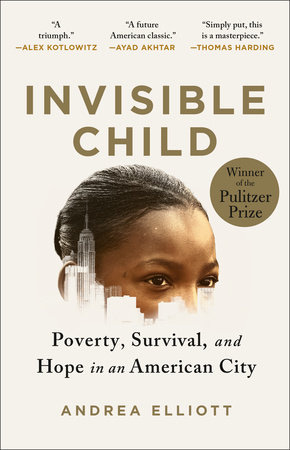Andrea Elliott wanted to explore poverty from a child’s perspective - she thought that event the most hard-hearted critic of “the unworthy poor” could not but understand that a child is not complicit in her own poverty; her poverty is not the result of one or more failures on her part.
So Elliott found Dasani, her parents and her seven siblings and worked with them for years, following and covering the family’s life in a shelter for homeless families, various flats, during long days on the streets and public transport, at school and at court, until there is a lucky break for Dasani, who through the intervention of various fairy godmothers is offered a scholarship at Milton Hershey School.
Hershey - chocolate magnate and rich man with a poor boy’s past - endowed a school for poor boys where they would be prepared for success in life; today, the school has facilities that rival the richest private schools’ and a team of house parents, teachers, and counselors that try to help children overcome whatever growing up poor did to them.
If this were a movie or a novel, the story would either end here, with Dasani expectantly entering Milton Hershey, or with her graduation, the hero of her own success story.
As is, life does not do cinematic happy endings, and so Dasani’s story does not end with her triumph over adversity at a school designed to lift children out of poverty.
Do not read on - hic sunt spoilers.
In my view, Elliott has done an admirable job as a journalist, embedding the reader in a situation that is so complex, so devoid of simple solutions that the story will haunt me for a long time - as it will probably haunt you, should you read it.
One of the strengths of the book is that it never shirks from acknowledging the “grey areas” that make it difficult to judge the people involved. Take Chanel, Dasani’s mother. She has never graduated from school, never held a job, never been able to provide her children with a stable home; she worked for a gang, was in prison, and encourages her daughter to fight other girls. Oh, and she has a history of substance abuse - not “mom material” by any means, and Elliott never glosses over her shortcomings. And yet, Elliott shows that Chanel is also a deeply committed mother who fiercely loves and protects her children as best she can - even though she can’t protect them from the fallout of her own addiction.
I admit I would judge a woman like Chanel harshly if I saw her in the street, but reading Elliott’s portrayal of Chanel has probably taught me to be less judgemental.
Elliott generally portrays the people in her book with admirable respect and fairness - even though she is fiercly on the side of Dasani’s family and has a bit of a bone to pick with some of the social workers, child protection people, lawyers and the bureaucrats of the foster care system. It is very clear that she feels they and the system they represent shortchange Dasani’s family in many ways.
At some point, the family is split up and the children are sent into foster care - creating trauma for everybody involved, from the children to the parents to Dasani, who at the time is studying away at Milton Hershey, enjoying the most stable year of her entire childhood. I had to put the book away for a few weeks when I realized that a traumatic separation and foster care were the children’s inevitable fate.
One could not envisage a sharper contrast than the one between the idyllic campus of Milton Hershey and Dasani’s New York. Milton Hershey, we learn, offers everything Dasani would need to get out of poverty, get out of homelessness, and become the first of her family to have a successful career. And yet, and yet, Milton Hershey cannot protect Dasani from her parents’ failure to keep the family together, and so Dasani finds herself back in her city, but not at home - because her home no longer exists.
As a reader, I had been rooting for Dasani to make it through Milton Hershey; it was painful to read about her experiences adjusting to a very different life - at that time, she needed her family more than she needed an education, and the heart wants what it wants, doesn’t it. Dasani could not transcend the deep inner need for her mother and siblings to focus on an education that would make life easier for all of them. She just couldn’t.
And yet, her story is a story of hope. My grandmother (who never had a chance to go to school beyond 8th grade) used to say: “Nobody can take what’s in your head.” - It seems that Dasani, too, left Milton Hershey with a lot of stuff in her head that would enable her to break the vicious circle the family had found itself in for decades. Today, Dasani - but also her mother and some of her siblings - have found at least some stability and future prospects that are much less bleak than that of their peers.
Invisible Child is a journalistic masterpiece and also a testimony to the value of human closeness beyond divisions of class and wealth - not only the observed, but also the observer has changed profoundly in the process of Dasani’s years as a child that was no longer to be invisible but that was chosen to shed light on the dark places we’d rather not acknowledge.
Seriously, read this book.



